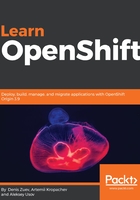
Passing environment variables to a container
At runtime, environment variables are exposed to the application inside the container. You can set environment variables in a service's containers with the environment key, just like with docker run -e VARIABLE=VALUE. You can also pass environment variables from your shell straight through to a service's containers with the environment key by not giving them a value, just like with docker run -e VARIABLE.
Environment variables are used to set specific application parameters, like IP addresses, for a server to connect the database server address with login credentials.
Some container startup scripts use environment variables to perform the initial configuration of an application.
For example, a mariadb image is created to use several environment variables to start a container and create users/databases at the start time. This image uses the following important parameters, among others:
First, we can try to pull and start a mariadb container without specifying the password/user/database-related information. It will fail since the image expects the parameters. In this example, we are starting a container in the foreground to be able to see all error messages:
$ docker pull mariadb
latest: Pulling from docker.io/library/mariadb
...
output truncated for brevity
...
Digest: sha256:d5f0bc88ba397233677ff75b7b1de693d5e84527ecf2b4f59adebf8d0bcac3c4
Now try to run mariadb container without any options and arguments.
$ docker run mariadb
error: database is uninitialized and password option is not specified
You need to specify one of MYSQL_ROOT_PASSWORD, MYSQL_ALLOW_EMPTY_PASSWORD and MYSQL_RANDOM_ROOT_PASSWORD
The docker run command failed because the MariaDB image initial startup script was not able to find the required variables. This script expects us to have at least the MariaDB root password to start a database server. Let's try to start a database container again by providing all required variables:
$ docker run -d --name mariadb -e MYSQL_ROOT_PASSWORD=password -e MYSQL_DATABASE=example -e MYSQL_USER=example_user -e MYSQL_PASSWORD=password mariadb
721dc752ed0929dbac4d8666741b15e1f371aefa664e497477b417fcafee06ce
Run the docker ps command to verify that the container is up and running:
$ docker ps
CONTAINER ID IMAGE COMMAND CREATED STATUS PORTS NAMES
721dc752ed09 mariadb "docker-entrypoint.sh" 10 seconds ago Up 9 seconds 3306/tcp mariadb
The container was created successfully. Run the verification command to check that example_user has access to the example database:
$ docker exec -it mariadb mysql -uexample_user -ppassword example -e "show databases;"
+--------------------+
| Database |
+--------------------+
| example |
| information_schema |
+--------------------+
The startup script created a user named example_user with the password password as we specified in the environment variables. It also configured a password for the root user. The full list of MariaDB image variables you can specify is located at https://hub.docker.com/_/mariadb/.
Parameter |
Description MYSQL_ROOT_PASSWORD |
This variable is mandatory and specifies the password that will be set for the MariaDB root superuser account. MYSQL_DATABASE |
This variable is optional and allows you to specify the name of a database to be created on image startup. If a user/password was supplied (parameters in the row below) then that user will be granted superuser access (corresponding to GRANT ALL) to this database. MYSQL_USER and MYSQL_PASSWORD |
These variables are optional and used in conjunction to create a new user and to set that user's password. This user will be granted superuser permissions for the database specified by the MYSQL_DATABASE variable. Both variables are required for a user to be created. |